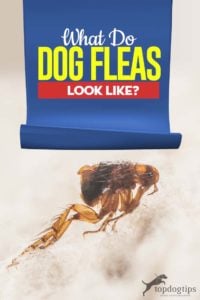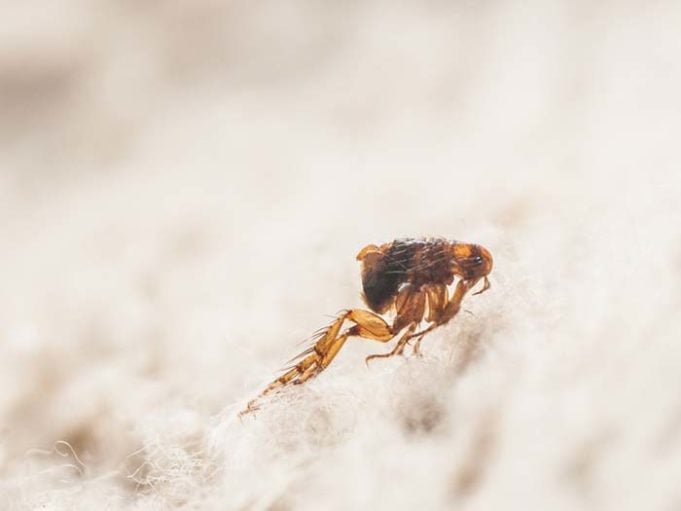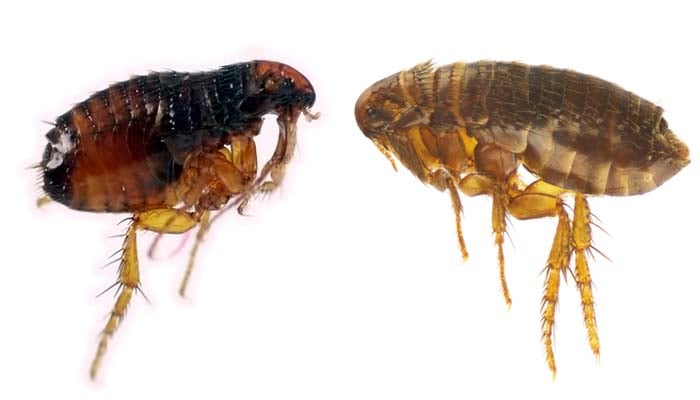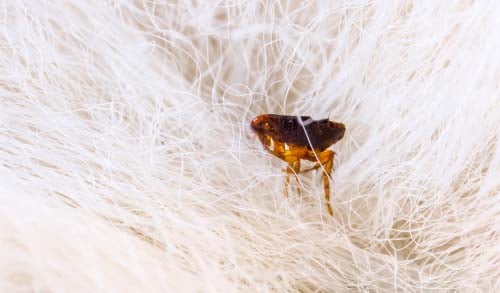As a dog owner, you must have seen a flea at least once. Even with the greatest attention to the dog’s hygiene, your pooch can easily catch fleas. This can lead to red marks and irritation, and you can see him struggling to get them off scratching himself relentlessly.
While flea bites are not dangerous for your dog, they are very irritating and if exposed to flea bites for a long time, the dog can get other diseases, usually due to infected bite wounds. However, fleas are not the only problem your dog may face; there are many other things which can attack your dog, like ticks, flies, and other insects.
So what do dog fleas look like and are there any different types? Let’s see how we can recognize a flea in all of its stadiums of development.
Types of Fleas
The fleas which concern us are dog fleas and cat fleas, the most popular ones.
This is what both of them look like:
While scientists can recognize the difference between the two, to the laymen they very much look alike and you will not be able to tell the difference.
Keep in mind that cat fleas are the most common ones. However, in spite of their name, they don’t just attack cats. They also attack dogs, other animals, and even humans. Dog fleas are also quite common and your dog is very likely to bring them home as well.
Places You Can Find Them
Even the cleanest dog is not spared of this nuisance. If your pooch likes to spend a lot of time outdoors, he will easily pick them up somewhere.
First of all, their habitat is nature, like woods or pastures, the places with a lot of shade and plants, leaves and tall grass. Because they like dark and wet places, the basement of a house sometimes has ideal conditions for the flea spread.
If you walk your dog solely on the pavement and there are not a lot of places where he can catch these parasites, he will still want to hang out with a neighbor’s dog, check him out or sniff him, and this is the perfect opportunity for a flea to change the host.
Appearance of an Adult Flea
An adult flea is quite small, but always visible to us.
This is what an adult flea looks like:
Adult flea's body is 2.5 millimeters long and covered in hair. Its hair is useful for remaining on the body of a host and moving around through a thick coat of your dog.
They are of brown or red-brown color and have six legs. They don’t have wings, but one of their important characteristics is that they are able to jump high and far. If you ever tried to kill a flea on your dog, you are probably familiar with this trait, because as soon as you try to put your finger around it, it will jump somewhere where you won’t find it.
Different Stadiums of the Development of Fleas
While your dog is most likely to catch an adult form of flea, this adult will start reproducing and multiplying very quickly, and its other forms are even more difficult to notice or get rid of.
1. Eggs
Flea life starts in an egg. One flea can lay almost 1000 eggs within one month, or 40-50 eggs per day. So, if you notice a flea on your dog it is very important to stop its spreading.
Flea eggs are in an oval shape, of very neutral translucent color. Their size is very small and it is difficult to see it with a naked eye even though they are usually in groupings of around 20 eggs. To put it in perspective, a flea egg is smaller than a grain of sand.
They don’t have the developed mechanism for remaining on your dog’s fur, and as he walks some of them will fall down. You can spot the eggs in the places where your dog usually sleeps if in larger quantities and separated from the fur.
2. Larvae
After feeding off your dog’s blood, eggs will hatch, and the next stadium will be a pupal stage when larvae appear.
This is probably the trickiest phase for getting rid of fleas on a dog because they develop a cocoon which is sticky so they don’t drop off your dog and immune to the chemicals used for killing fleas. The same spray which helps with adult fleas doesn’t help with fleas in the pupal stage. The larvae casing is even waterproof, so bathing your dog, won’t affect the fleas inside it, it can only make it drop off.
Instead of flea collars with pesticides, or other chemical products which can be used against adult fleas, larvae can be beaten only mechanically. Usually vacuuming and cleaning the house helps because it increases the house temperature and causes vibrations which are good conditions for fleas to hatch when they can be killed by regular flea-killers.
3. Flea Dirt
While not technically a stage in the development of fleas, there is another thing about them which you should learn to recognize. This is flea feces or more commonly known as “flea dirt”. After a flea has an abundant meal off your dog, it leaves behind the feces.
It looks similar to the dirt your dog gets inside the house when playing outside, so when in doubt as to whether these are feces or regular dirt, try putting a bit of it on your finger. If it falls apart, this is most likely flea dirt. Other types of dirt will remain solid and coherent on your finger.
Sometimes it can be difficult to spot an actual flea, especially if your dog doesn’t have too many of them yet. This is why flea feces are a reliable indicator that your dog has fleas, and you can start with curing measures.
Summary
 Fleas are very common in a dog’s and dog owner's life. Some preventive measures against them are collars, flea drops, or other flea preventatives; and for your home, you can use flea powders, flea traps or flea sprays. It's very often that you have to get rid of them going through a full process, once your dog actually brings them home.
Fleas are very common in a dog’s and dog owner's life. Some preventive measures against them are collars, flea drops, or other flea preventatives; and for your home, you can use flea powders, flea traps or flea sprays. It's very often that you have to get rid of them going through a full process, once your dog actually brings them home.
This is why it is important to know that fleas go through several stages of development- egg, larvae and adult flea. You can spot them in your dog’s fur only in an adult stage, while in the earlier stages your best option is to look for flea dirt which is a sign that there is a flea battle in front of you and your furry friend.
READ NEXT: Dog Scratching But No Fleas? 8 Other Causes of Itching and Solutions















